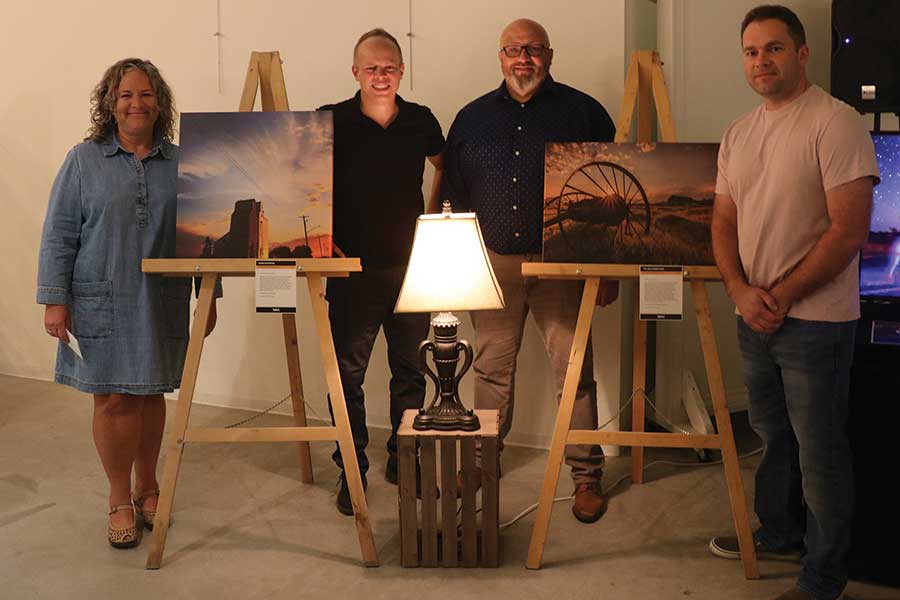For photographers Steve Hiebert and Joey Siemens, this month’s Landscapes in Focus exhibit at Winkler Arts and Culture is also as much about perhaps inspiring others.
Speaking at the opening reception at the Park St. gallery last Thursday, both said they would love it if the show, which features their work as well as photos from other local artists, inspired more people to get out and enjoy the Pembina Valley, perhaps with a camera in hand.
“We wanted to bring this exhibit to the community just as a way to kind of promote photography in the area,” said Siemens. “We’re featuring a lot of work that is showing areas of the Pembina Valley.
“We all have a real passion for it, and we do hope that passion might spill over to others and get them excited and interested and even just have them go out there and enjoy the beauty of the Pembina Valley because we live in such a great area,” said Hiebert.
Landscapes in Focus is a photography exhibition that celebrates the beauty of the region while also showcasing striking landscapes from beyond the area.
The exhibit captures the essence of the surrounding scenery with rolling prairies, dramatic skies and quiet natural moments. Complementing these are a selection of landscape images from outside the region offering a broader look at places that have inspired the photographers.
Despite his years of experience with a camera, this exhibit represents the first major exhibition of Hiebert’s photos.
“This is something fairly new for me actually. I have had images in Morden at the art gallery, but doing a collaboration like this with other photographers, this is a first, and I’m really excited about it,” he said. “It’s great to get the community of people, of photographers together.”
“That’s kind of what this is all about,” agreed Siemens. “It’s to collaborate with each other and increase that awareness of what is out there in the landscape of our communities. The Pembina Valley is just a beautiful area.
“And I know there’s a lot of people in this area who are interested in photography,” he added. “So it’s kind of our way to promote that curiosity and help nurture it.”
There is endless potential in this region for capturing great landscape images, Hiebert suggested.
“And every year is different. No two years are the same. You never know what you might find when you go out. The light’s different every time you go out, and you can just keep going and going, and there’s always something beautiful to shoot.”
Some level of skill and knowledge is obviously needed, but it is something that can be learned and developed with time and patience.
“There’s got to be some dedication,” Hiebert said, citing the example of being prepared to go out at night.
“You’re guaranteed to never get a good shot if you don’t go out,” Siemens agreed.
Hiebert cited one image in particular showing nebulae that required about 12 hours of imaging time, and it is that kind of astral deep sky photography that particularly appeals to him.
“I’m working at some right now … I’m into 86 hours,” he estimated. “When I’m done, I’m hoping it will be 150 hours on one image. Just the photography. That’s not counting the hours of work that follow.
“It’s very unique … but what you get out of it is amazing,” he continued. “And I love to share my work with people and let them see what’s out there. It’s right above them but they don’t see it.”
What inspires them the most when it comes to their photos?
“For me, it’s just the creation that’s out there and seeing the beauty everywhere. I just want to capture that,” said Hiebert. “It might be right in your backyard, but if you’ve never actually stopped to look at it … there’s beauty everywhere. You just have to slow down and look at it.”
“We live in such a fast paced world … so for me, photography has allowed me to get out into nature because I love being in the outdoors. I’m out there admiring what’s out there, but having a camera with me means I get to see things in a different way because I just slow down,” said Siemens.
“I reflect on what’s there, and then that whole creative process starts to work. I can turn this scene into something that can tell a story because it evokes emotions and feelings, so you’re connecting with it. That is probably the prime reason why I do this,” he said.
Both appreciated having the opportunity to see the end results of their work on display.
“It feels good to look around and see this display and to see a community come out and support this,” said Hiebert.
“It allows you to kind of take a step back and look at it … and you can start even learning more about it,” added Siemens.
“I think incredible is a good way to summarize the artwork that you see on the walls here, said Winkler Arts and Culture executive director Jered Hildebrand. “A number of the pieces are taken from right here in the Pembina Valley … so to see the variety of landscapes that we have in our region and how well it is documented with the quality of the images, this is just an absolutely really well done exhibit.”
The exhibit’s opening reception also revealed the winners of a photography contest that was run in conjunction with the show.
The judges choice award went to Eugen Klassen for his image dubbed The Old Farmyard, while the runner-up was Lisa Harder. The community choice award winner was Jennifer Loewen for her Kane Elevator shot, while the runner-up was Elizabeth Froese.

